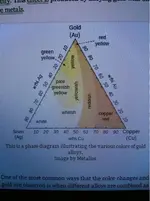Boarteats
Full Member
- Joined
- Mar 25, 2018
- Messages
- 134
- Reaction score
- 137
- Golden Thread
- 0
- Location
- Near Baltimore
- Detector(s) used
- Falcon MD20
- Primary Interest:
- Prospecting
Amazon Forum Fav 👍
Upvote
0
Dont look like it from here.

Not sure what the silvery metal is, but that one nugget is gold. No doubt. I’m getting mostly silver (in the form of silver chloride) from this stream but have gotten a few gold flakes along with a some flour gold recently. Just hit a spot where rocks are all covered in what appears to be manganese (dioxide), which is where this nugget came from.
The source stream is actually pretty interesting. Finding good spots takes a good amount of detective work (and a lot of digging). Fun for a hobbyist but not going to get rich.

Dark rock in the center of the picture?? do you mean center of the rocks ? I see no gold just dark rocks.
But if you say it's gold that's good enough for me -- I like gold and dark rocks.
Cheers Mike
 .
.
I've never panned or did any gold prospecting but I have a pan and have threatened a few streams in my area that I was coming. I never knew that gold could have anything "stuck" to it? I know it doesn't really tarnish and any gold I've found metal detecting was completely clean. Is it possible to have gold coated with other things? How would one be able to distinguish that from other things in the pan if that were true? Again, I know nothing gold hunting.
 .
.In my area, gold can be found where there is manganese and iron oxides. Manganese dioxide is a dark mineral that coats everything around it, rocks, gold, pets, whatever. The gold itself isn't oxidized, just disguised.
I've read that manganese can dissolve gold. In fact, it's an important part of some common fluxes used for smelting gold from "black sands". According to what I've read, Iron oxides such as magnetite can precipitate dissolved gold from manganese. Info is on Internet, so it has to be accurate, right ?.
WRT identifying non-obvious gold. Not easy. When panning, I just examine anything heavy and metallic looking. Gold is much heavier than just about anything else found with it. So, when panning, it will not move much even when everything else is swirlling around.
caveat: I'm only a prospecting hobbyist, not an expert.
I love and agree with everything you said here except the bit about manganese in flux. That is a MISTAKE. Do not use fluxes with manganese unless you want your gold contaminated with manganese!

I've never panned or did any gold prospecting but I have a pan and have threatened a few streams in my area that I was coming. I never knew that gold could have anything "stuck" to it? I know it doesn't really tarnish and any gold I've found metal detecting was completely clean. Is it possible to have gold coated with other things? How would one be able to distinguish that from other things in the pan if that were true? Again, I know nothing gold hunting.
I’m not a pro when it comes to prospecting and/or gold smelting, so I’m very much inclined to accept advice from more experienced folks. Take any/all of my comments with many grains of salt.
When looking for a flux for smelting black sands, I came across Chapman flux. It contains Borax, Soda Ash, Manganese Dioxide, and Silica. Seemed like a pretty common flux for this purpose. To make it work, I found that it was necessary to use a collector metal as well because my black sand wasn’t terribly good quality. I used silver. Gold preferentially alloys with silver over the other stuff in my source material. Of course, this creates another problem. Gotta part gold and silver after smelting.
I don’t believe that chapman would be a good choice as a general purpose gold smelting flux, however.
As an aside, using a blast furnace that I built myself for smelting was really fun.
Manganese is a poor choice of a collector metal since you probably won’t get it all out of the gold afterward. Lead is better by far since you can cupel it out easily in your blast furnace.
I’m told Mr Chapman used manganese because he had a source of it for free. SMH ��*♂️
We learned to inspect all the black rocks that just won't leave the gold in the pan. We get what we call black nuggets occasionally. Gold with a reddish hue usually indicates copper. The northeastern areas in California had a lot of copper mines with a co-product of gold.
